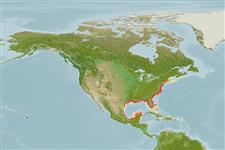>
Blenniiformes (Blennies) >
Blenniidae (Combtooth blennies) > Salariinae
Etymology: Hypsoblennius: Greek, hypsi = high + Greek, blennios = mucus (Ref. 45335).
More on author: Lesueur.
Environment: milieu / climate zone / depth range / distribution range
Ecologie
marien rifbewoner. Temperate; 46°N - 18°N, 98°W - 62°W
Western Atlantic: New Jersey (occasionally Nova Scotia in Canada) to Texas, including southern Florida in USA.
Grootte / Gewicht / Leeftijd
Maturity: Lm ? range ? - ? cm
Max length : 10.0 cm TL mannelijk / geslacht onbekend; (Ref. 7251)
Dorsale stekels (totaal): 11 - 13; Dorsale zachte stralen (totaal): 13-16; Anale stekels 2. Gill opening extending ventrally to opposite 7th-11th pectoral-fin ray; segmented dorsal-fin rays 13-16; segmented pelvic-fin rays 3; last dorsal-fin spine 8.5-15.5% SL; dorsal-fin spines robust and stiff; no elongate fleshy flap present posteriorly on lower lip; infraorbital bones 5-5; upper lip without free dorsal margin extending around snout; fleshy lobes of lower lip almost linear in lateral view and separated anterioventrally by a broad smooth area; bony interorbital width comparatively wider; dark spot usually present in spinous dorsal fin and centered on second spine; mandibular pores 4.
Adults inhabit oyster reefs and rocky shores. Oviparous. Eggs are demersal and adhesive (Ref. 205), and are attached to the substrate via a filamentous, adhesive pad or pedestal (Ref. 94114). Larvae are planktonic, often found in shallow, coastal waters (Ref. 94114).
Levenscyclus en paargedrag
Maturiteit | Voortplanting | Paaien | Eieren | Fecunditeit | Larven
Oviparous, distinct pairing (Ref. 205).
Robins, C.R. and G.C. Ray, 1986. A field guide to Atlantic coast fishes of North America. Houghton Mifflin Company, Boston, U.S.A. 354 p. (Ref. 7251)
Status op de Rode Lijst van het IUCN (Ref. 130435)
Gevaar voor de mens
Harmless
Gebruik door de mens
Visserij: van geen belang
Meer informatie
ReferentiesAquacultuurAquacultuurprofielKweeklijnenGeneticaElectrophoresesErfelijkheidZiektesVerwerkingNutrientsMassaconversie
Tools
Speciale rapporten
Download XML
Internetbronnen
Estimates based on models
Preferred temperature (Ref.
123201): 12.5 - 26.1, mean 23.7 °C (based on 188 cells).
Fylogenetische diversiteitsindex (Ref.
82804): PD
50 = 0.5000 [Uniqueness, from 0.5 = low to 2.0 = high].
Bayesian length-weight: a=0.00741 (0.00335 - 0.01640), b=3.02 (2.83 - 3.21), in cm total length, based on LWR estimates for this (Sub)family-body shape (Ref.
93245).
Trofisch niveau (Ref.
69278): 2.8 ±0.2 se; based on size and trophs of closest relatives
Weerstandsvermogen (Ref.
120179): Hoog, minimale populatieverdubbelingstijd minder dan 15 maanden (Preliminary K or Fecundity.).
Fishing Vulnerability (Ref.
59153): Low vulnerability (10 of 100).
Nutrients (Ref.
124155): Calcium = 51.5 [16.8, 99.3] mg/100g; Iron = 0.286 [0.140, 0.560] mg/100g; Protein = 18.4 [17.1, 19.7] %; Omega3 = 0.233 [0.105, 0.504] g/100g; Selenium = 5.02 [1.83, 13.23] μg/100g; VitaminA = 86 [18, 428] μg/100g; Zinc = 1.1 [0.7, 1.8] mg/100g (wet weight);
